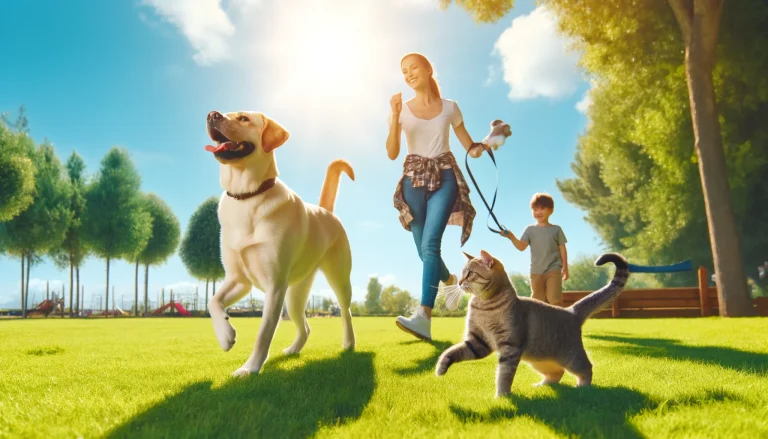The Importance of Exercise for Pets
Is your pet getting enough exercise? Just like humans, our furry friends require regular physical activity to maintain optimal health and behavior. Many pet owners recognize the need for exercise, but often overlook just how profound pet exercise benefits can be on their pet’s overall well-being. From enhancing mood to managing weight, the benefits of exercise are significant and multifaceted.
Exercise isn’t just about keeping your pet physically fit; it’s also crucial for mental health, reducing instances of anxiety and boredom that often lead to behavioral issues. An active pet is a happy pet, and by integrating regular exercise into your daily routine, you can foster a vibrant and enriching life for both you and your animal companion.
As we delve deeper into this topic, we’ll explore how regular physical activity can transform your pet’s life, providing practical tips to effectively incorporate exercise into their routine. Whether you’re looking to improve your pet’s mood, boost their health, or simply enjoy more active time together, understanding the critical role of exercise is your first step. Let’s embark on this journey to unlock a happier, healthier lifestyle for your beloved pets.
Understanding Pet Behavior: The Impact of Exercise
Pet exercise benefits play a pivotal role in the behavior of pets, influencing everything from their mood to their daily interactions. A well-exercised pet is typically more even-tempered and sociable. Conversely, a lack of physical activity can lead to a variety of behavioral problems, such as aggression, excessive barking or meowing, and destructive behaviors like chewing and scratching.
How Exercise Influences Behavior
Physical activity helps to burn off excess energy that, if pent up, could manifest as hyperactivity or aggression. Regular exercise sessions are especially crucial for high-energy breeds that are naturally inclined to be more active. These sessions provide an outlet for energy and stimulate the mind, which can significantly reduce incidents of misbehavior.
Exercise also stimulates the production of serotonin, a chemical in the brain that helps to regulate mood and anxiety. The natural high that humans experience after a workout, often referred to as the “runner’s high,” also occurs in animals. This biochemical boost can make your pet feel more relaxed and content throughout the day.
Examples of Behavioral Improvements Through Regular Activity
Many pet owners report a noticeable improvement in their pets’ demeanor with regular exercise. For example, dogs that receive daily walks and playtime are less likely to exhibit anxiety when left alone. They are generally calmer and more approachable, showing less reactivity to stimuli that might otherwise trigger a loud or aggressive response.
Similarly, engaging cats in play that mimics hunting behavior, such as chasing laser pointers or feather wands, can alleviate boredom and prevent the common problem of nighttime activity bursts, ensuring they are more relaxed and less prone to destructive behaviors.
Incorporating adequate physical activity into your pet’s routine isn’t just a good practice; it’s an essential part of fostering a stable and happy environment. By understanding the direct correlation between pet exercise benefits and behavior, pet owners can make informed decisions that enhance their pets’ quality of life and prevent common behavioral issues.

Physical Health Benefits of Regular Exercise for Pets
Pet exercise benefits are crucial for maintaining the physical health of your pets, providing numerous advantages that extend well beyond simple weight management. Consistent physical activity helps prevent a range of common health issues, including obesity, which is linked to serious conditions such as diabetes, heart disease, and joint problems.
Cardiovascular Health
Just like in humans, regular exercise strengthens the cardiovascular system of pets. Increased activity promotes better heart health and improves circulation, reducing the risk of heart disease. Pets that engage in daily exercise often exhibit increased stamina and endurance, which contributes to overall vitality and longevity.
Weight Management
Exercise plays a key role in managing your pet’s weight. It helps burn calories, reduces appetite, and increases metabolism, all of which are important for maintaining a healthy weight. Proper weight management decreases the stress on joints and can significantly reduce the risk of arthritis in pets as they age.
Enhanced Mobility and Agility
Regular physical activity also enhances a pet’s mobility and agility. Pets that are active are less likely to suffer from the stiffness associated with sedentary lifestyles. Exercise keeps muscles toned and joints flexible, which is particularly beneficial for aging pets who might otherwise struggle with mobility issues.
With regular exercise into your pet’s routine, you not only improve their physical condition but also enhance their overall quality of life, ensuring they remain healthy, active, and energetic throughout their lives.
Different Types of Exercises for Various Pets
Tailoring exercise routines to the specific needs and characteristics of different pets ensures they get the most benefit from their activity sessions. Here’s a look at suitable exercises for dogs and cats, the most common household pets.
Exercises Suitable for Dogs
Dogs require varied forms of exercise to meet their energy levels and physical capabilities:
- Walking and Running: Daily walks are essential, not just for exercise but also for mental stimulation. For more energetic breeds, running or jogging provides a great outlet for their energy.
- Fetch and Frisbee: Games like fetch or frisbee challenge a dog’s speed and dexterity while providing fun and interactive ways to exercise.
- Agility Training: Setting up an obstacle course in your backyard or joining a local agility club can greatly enhance a dog’s physical and mental agility.
- Swimming: For breeds that love water, swimming is an excellent exercise that minimizes stress on joints while providing a thorough workout.
Exercises Suitable for Cats
Cats typically enjoy shorter, more frequent sessions of play that mimic their natural hunting behaviors:
- Interactive Toys: Toys that mimic the movement of prey, such as laser pointers or feather wands, engage a cat’s natural hunting instincts.
- Climbing Structures: Cat trees or climbing shelves encourage climbing and jumping, which are great for agility.
- Puzzle Feeders: These make a cat work for their food, engaging both their mind and body.
- Tunnels and Boxes: Simple cardboard boxes or tunnels can provide hours of entertainment and physical exercise for cats.
Incorporating these activities into your pet’s daily routine can help satisfy their natural instincts and provide necessary physical exercise. Whether it’s a leisurely walk, a vigorous game of fetch, or a challenging puzzle feeder, these exercises are vital for keeping your pets healthy and engaged. Pet exercise benefits are clear, as they ensure your pet stays fit, happy, and mentally stimulated.
Creating a Sustainable Exercise Routine for Your Pet
Establishing a consistent and sustainable exercise routine is essential for keeping your pet healthy and happy. Here’s how you can create a routine that fits both your lifestyle and your pet’s needs.
Establishing a Daily Schedule
Consistency is key when it comes to pet exercise. Set specific times each day for physical activity, which helps your pet anticipate and prepare for exercise, reducing anxiety and increasing enthusiasm. For dogs, morning walks or play sessions can set a positive tone for the day, while evening activities may help them wind down before bedtime. Cats benefit from shorter, more frequent play sessions throughout the day.
Adjusting Intensity and Duration
The intensity and duration of exercise should be tailored to your pet’s age, breed, and health status. Younger pets may require more vigorous and extended sessions to burn off excess energy, whereas older pets may benefit from gentler, shorter sessions to maintain mobility without overexertion. Always start slow and gradually increase the intensity to gauge your pet’s endurance and prevent injuries.
Incorporating Variety
Variety not only keeps exercise engaging for your pet but also ensures that different muscle groups are worked, and various skills are developed. Alternate between walks, interactive play, and training exercises. For dogs, mix leashed walks with free-play in a secure area. For cats, rotate the toys you use to keep playtime fresh and stimulating.
Monitoring Your Pet’s Response
Pay close attention to how your pet responds during and after exercise. Look for signs of fatigue, such as heavy panting or lagging behind, and adjust the routine accordingly. Positive responses, such as eagerness to start the activity, indicate that the exercise routine is well-suited to your pet.
Regular Reviews and Adjustments
As your pet ages or their health changes, their exercise needs will also evolve. Regularly review and adjust the exercise routine to align with these changes. Consulting with a veterinarian can provide insights into the most appropriate types of activities based on your pet’s health.
Following these guidelines will help you develop a sustainable exercise routine that will keep your pet physically active and mentally stimulated. This commitment to regular activity highlights the numerous pet exercise benefits crucial for your pet’s long-term health and well-being, fostering a joyful and energetic companion.
Engaging Your Pet in Exercise: Tips and Tricks
Getting your pet excited about exercise is key to maintaining an effective routine. Here are some tips and tricks to make physical activity fun and engaging, ensuring your pet stays motivated and enthusiastic about their daily workouts. Understanding and leveraging pet exercise benefits can significantly enhance your pet’s overall health and happiness.
Making Exercise Fun and Rewarding
To make exercise appealing, infuse it with fun and playfulness. For dogs, games like tug-of-war or hide-and-seek with toys can make physical activity feel like playtime. Cats often enjoy chasing lasers or fluttering feathers. The key is to engage your pet’s natural instincts and preferences, making the activity something they look forward to.
Interactive Toys and Games
Interactive toys can significantly enhance your pet’s playtime. Treat-dispensing toys motivate pets by rewarding them with treats, making the exercise both mentally stimulating and physically rewarding. Puzzle toys that require pets to solve a problem to receive a reward can keep them engaged and active, especially for cats.
Using Treats and Rewards Effectively
Rewards are a powerful motivator for pets during exercise. Use small, healthy treats to encourage your pet during and after their exercise sessions. For instance, rewarding a dog with a treat after a successful fetch or obedience maneuver reinforces their training and makes the activity more enjoyable. For cats, immediate rewards after playful pounces can encourage more active engagement.
Encouraging Routine Participation
Consistency helps build habits, so schedule exercise at the same time each day. This regularity helps pets anticipate and prepare for activity, reducing reluctance. Over time, as exercise becomes a regular part of their day, most pets will begin to initiate the activity themselves, showing eagerness when it’s time for their walk or play session.
Adapting to Your Pet’s Interests
Pay attention to what types of activities your pet enjoys most. Some dogs may prefer long hikes, while others might enjoy a simple game of fetch in the backyard. Cats may favor a specific type of toy or might be more inclined to engage when you actively participate in play. Tailoring activities to your pet’s preferences can make exercise more effective and enjoyable for them.
Use this tips to engage your pet, you can turn exercise from a mundane necessity into a highlight of the day for both of you. Engaged and active pets are not only healthier but also happier, which greatly enhances the quality of life they share with their owners.

Success Stories: Real-Life Benefits Seen by Pet Owners
Hearing from pet owners who have seen tangible improvements in their pets’ behavior and health through regular exercise can be incredibly motivating. Here are some testimonials and examples that highlight the positive impact of consistent physical activity on pets.
Increased Happiness and Reduced Anxiety
Janet from Seattle noticed a significant change in her once-anxious Border Collie, Max. “Before we started a regular exercise routine, Max was always a bit on edge, especially when left alone. After integrating two daily walks and regular fetch sessions into our routine, his anxiety has decreased noticeably. He’s more relaxed at home, and his destructive chewing has stopped. It’s like he’s a completely different dog,” she explains.
Weight Loss and Improved Mobility
Tom, a cat owner from Austin, shared his experience with his cat, Whiskers. “Whiskers was overweight, which made him sluggish and lethargic. Our vet recommended daily interactive play sessions to help him lose weight. We started using a laser pointer and puzzle feeders, and he’s lost 3 pounds! His energy levels are up, and he’s more agile and active around the house,” Tom reports.
Enhanced Social Skills
Emma from Denver found that regular visits to the dog park have transformed her shy poodle, Bella, into a sociable pet. “Bella used to shy away from both humans and other dogs. It was sad to see her so withdrawn. We started going to the dog park regularly, and she’s done a complete 180. She now looks forward to her park time and has made several dog friends. Her confidence has soared, and it’s wonderful to see her interacting so happily,” Emma notes.
Longevity and Overall Health
Mark in Miami has seen the long-term benefits of exercise for his senior dog, Rocky. “Rocky is turning 12 this year, and thanks to a consistent, gentle exercise regime, he’s maintained great health. Our vet is always impressed with his cardiovascular health and joint mobility, which she attributes to his daily gentle walks and swim sessions. I believe these activities have added years to his life,” says Mark.
These stories underscore the profound effect that regular exercise can have on pets. Not only does it improve their physical health, reducing the risk of diseases and mobility issues, but it also enhances their mental well-being and social skills. By committing to regular physical activity, pet owners can provide their furry companions with a higher quality of life and countless joyful years ahead.
Championing Regular Exercise for Pet Health and Happiness
Throughout this blog, we’ve explored the undeniable pet exercise benefits, which include enhanced behavioral patterns, improved physical health, increased social skills, and overall better quality of life. Exercise isn’t just a supplementary part of pet care; it’s a fundamental aspect that fosters a happier, healthier pet.
The stories shared by pet owners vividly illustrate how a consistent exercise regimen can transform pets from anxious, unhealthy, or withdrawn into vibrant, healthy, and socially engaged companions. These testimonials underscore the tangible benefits that physical activity can deliver, not just in the short term but throughout the entire lifespan of your pet.
Conclusion
As a pet owner, integrating regular exercise into your daily pet care routine is one of the most loving and beneficial actions you can take. Whether it’s a leisurely walk, a stimulating game of fetch, or engaging interactive play, each activity contributes significantly to your pet’s well-being.
We encourage all pet owners to take this step towards enhancing their pets’ lives. Start small, perhaps with a short walk or a brief play session, and gradually increase the activity level. Observe how your pet responds and tailor the activities to suit their needs and preferences. Remember, the goal is not just to keep your pets fit, but to enrich their lives, strengthening the bond you share with them.
By prioritizing exercise, you’re not only ensuring your pet’s physical and mental health but also paving the way for a joyful and energetic companion who will bring happiness and activity into your life for years to come. Let’s make exercise a key part of our pets’ lives and enjoy the numerous benefits it brings together.
For more tips and information on how to care for your pets visit our blog.



